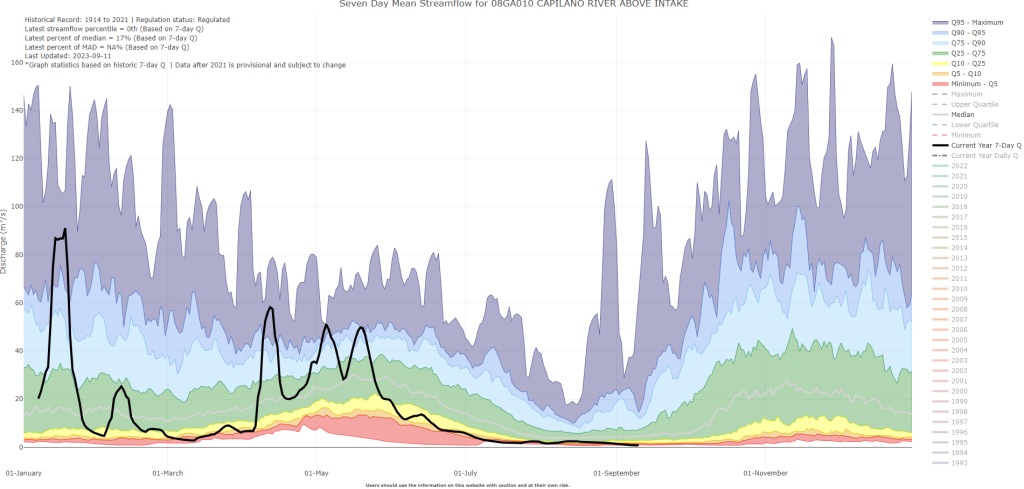Metro Vancouver’s watersheds are very dry

Posted September 12, 2023 7:31 am.
Last Updated September 12, 2023 7:34 am.
As Stage Two water restrictions continue to be enforced in Metro Vancouver, drought conditions are drying out the region’s watersheds.
Despite a significant snowpack this year, streamflows into the Capilano and Coquitlam Lake reservoirs have hit seasonal lows early, with the seven-day mean streamflow into Capilano Lake currently at the lowest it has ever been measured since records started being regularly kept in 1914.

The seven-day-mean streamflow into the Capilano River Reservoir in Metro Vancouver, as of Sept. 12, 2023. (Courtesy Metro Vancouver)
“We monitor inflows and levels into the three reservoirs [Capilano, Seymour and Coquitlam] regularly,” said Linda Parkinson, director of planning and analysis for Metro Vancouver’s Water Services Department.
“This year we have seen a very extended dry period that started in May and has run all the way to September and is projected into the fall. What was unusual and a little bit unique for this year was that the snowpack melted away earlier than usual … and so these low streamflows were expected.”
Related articles:
-
Metro Vancouver residents continue to water lawns despite Stage 2 restrictions, district says
-
B.C. drought ‘a sleeping giant of a natural disaster’: province
-
Metro Vancouver tightens water restrictions as drought becomes new normal
Parkinson says there are two factors that influence how much reservoirs fill up with snowmelt.
“There’s how much snow is present and then there’s the timing around when it melts,” she explained.
“If it all melts very early, we can get that run-off coming in and it’s not necessarily all captured into the reservoirs. So it’s not just volume of snow, it’s also the timing of the melt. This year the snowpack was gone by the end of June, two to three weeks earlier.”
That early melt was one of the factors — along with reservoir levels and higher-than-normal household demand — that prompted the regional district to implement Stage Two water restrictions on Aug. 4.
“Really, the only thing we can control right now is the demand, so the decision was made to stop discretionary outdoor use of drinking water, which is the biggest thing that drives demand in the high season. That’s when we brought into effect the lawn watering ban for residential and non-residential properties across the region,” she told CityNews.

The seven-day-mean streamflow into the Capilano River Reservoir in Metro Vancouver, as of Sept. 12, 2023. (Courtesy Metro Vancouver)
As water usage has tapered off from the highs of earlier this summer, Parkinson is optimistic residents will continue to conserve.
“If we keep the demand down, then the water we have in reservoirs should last us through a dry fall to when the rains come again,” she said.

As of the last measurement on Sept. 3, Metro Vancouver’s reservoirs were at 56 per cent of maximum, which is within normal range for this time of year.
“I know people can feel that it rains here so we have water, but it is far more complex than that. It’s about where it rains, when it rains, if that rain can be captured, how the snowmelt interacts with the precipitation — there’s a lot of factors that go into it,” Parkinson added.
“I’ve lived in Vancouver for 10 years now and it goes from being very wet to very dry very quickly.”








